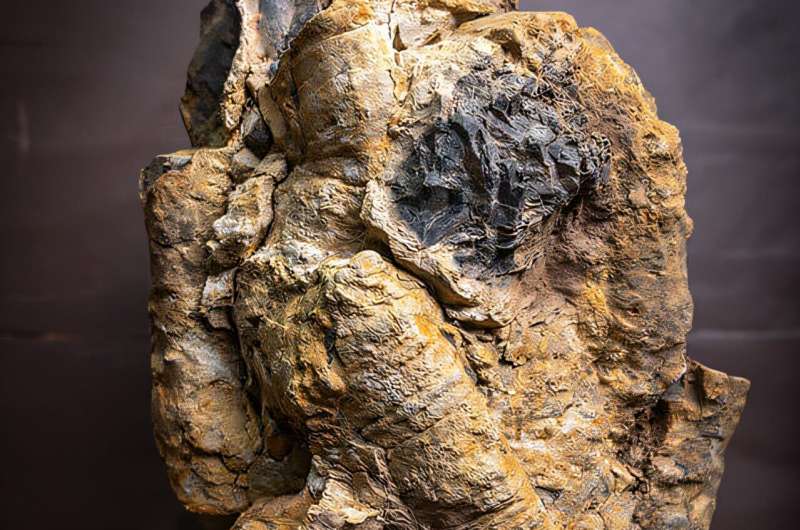Science
Vast Sea Sponge Habitat Discovered in Ancient Intermountain West

Researchers have uncovered evidence that a significant portion of the prehistoric Intermountain West was once dominated by an expansive habitat of sea sponges. A recent study published in the journal PLOS One details how this region, spanning nearly 400 miles from northeastern Nevada to southwest Montana, was once blanketed in tube-shaped sponges, providing a glimpse into an extraordinary ancient ecosystem.
Leif Tapanila, director of the Idaho Museum of Natural History and professor of geosciences at Idaho State University, emphasized the implications of this discovery. “If you were snorkeling, all you’d see would be a meadow of billions of tube-shaped sponges that went off into the distance,” he remarked. The research team focused on tube-shaped chert, a type of quartz found at multiple sites across the Intermountain West, which contains tiny glass-like structures known as spicules.
Spicules are unique to sponges and serve as their skeletal components. Tapanila explained, “To us, that supports the idea that this part of the Phosphoria Sea was covered in sponges.” This ancient body of water, existing approximately 275 million years ago, served as a vital marine habitat off the west coast of prehistoric North America. Today, the remnants of the Phosphoria Sea are located in East Idaho, where phosphate mines operate, supplying fertilizer.
Geologists initially discovered these tube-shaped chert formations during phosphate ore explorations in the 1950s and 1960s. Some paleontologists speculated about their origins, suggesting they could be remnants of fossilized burrows from extinct animals. Reflecting on past research, Tapanila noted, “Looking back at the old scientific papers, it was hidden in plain sight; they didn’t know what they had.”
This new research enhances understanding of the Phosphoria Sea, revealing it as one of the largest ecosystems of its kind. The study highlights not only the sponges but also the diverse marine life that thrived in that era, including the formidable giant buzzsaw shark, Helicoprion, and nautiloids, a group of shell-bearing squid. Tapanila described the ecosystem as “really one of the most remarkable ecosystems in the history of North America,” noting its rich biodiversity.
The findings from this research contribute significantly to the scientific narrative surrounding the Phosphoria Sea, illustrating the complex relationships within its ecosystem. Tapanila concluded, “The richness and complexity in the ecosystem of the Phosphoria Sea were off the charts.”
This study, led by Zackery Wistort and colleagues, underscores the importance of understanding ancient marine environments and their ecosystems. The full findings are detailed in the paper titled “Glass factory found: Basinwide (600 km) preservation of sponges on the Phosphoria glass ramp, Permian, USA,” which can be accessed in PLOS One.
As researchers continue to explore the geological history of the Intermountain West, these discoveries shed light on the ancient marine life that once thrived in an environment vastly different from today’s landscape.
-

 Science4 weeks ago
Science4 weeks agoInventor Achieves Breakthrough with 2 Billion FPS Laser Video
-

 Health4 weeks ago
Health4 weeks agoCommunity Unites for 7th Annual Into the Light Walk for Mental Health
-

 Top Stories4 weeks ago
Top Stories4 weeks agoCharlie Sheen’s New Romance: ‘Glowing’ with Younger Partner
-

 Entertainment4 weeks ago
Entertainment4 weeks agoDua Lipa Aces GCSE Spanish, Sparks Super Bowl Buzz with Fans
-

 Business4 weeks ago
Business4 weeks agoTyler Technologies Set to Reveal Q3 Earnings on October 22
-

 Entertainment4 weeks ago
Entertainment4 weeks agoMother Fights to Reunite with Children After Kidnapping in New Drama
-

 Health4 weeks ago
Health4 weeks agoCurium Group, PeptiDream, and PDRadiopharma Launch Key Cancer Trial
-

 World4 weeks ago
World4 weeks agoR&B Icon D’Angelo Dies at 51, Leaving Lasting Legacy
-

 Health4 weeks ago
Health4 weeks agoNorth Carolina’s Biotech Boom: Billions in New Investments
-

 Entertainment4 weeks ago
Entertainment4 weeks agoRed Sox’s Bregman to Become Free Agent; Tigers Commit to Skubal
-

 Science4 weeks ago
Science4 weeks agoNorth Carolina’s Biotech Boom: Billions Invested in Manufacturing
-

 Top Stories4 weeks ago
Top Stories4 weeks agoFormer Mozilla CMO Launches AI-Driven Cannabis Cocktail Brand Fast









